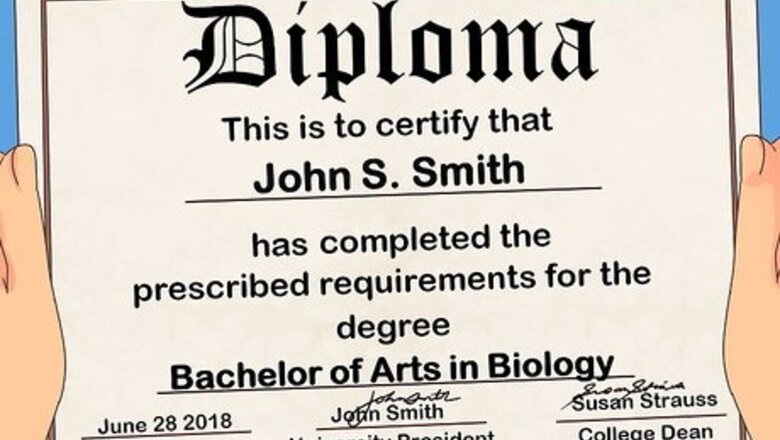
views
Gaining the Necessary Photography Skills

Get a journalism or science-focused college degree. While you do not need to major in photojournalism, or journalism at all, to get in with Nat Geo, you do need a college degree. Though your degree can be in something completely unrelated to photojournalism, it is encouraged that you take photography classes and practice constantly. Many Nat Geo photographers use their educational backgrounds to help them with shooting. For example, numerous freelancers have solid science backgrounds, which makes them excellent photographers of natural history.
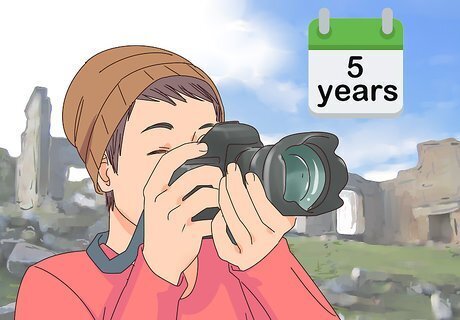
Spend five or more years working in photojournalism. Some National Geographic photographers started their careers at local newspapers or magazines as staff photographers. Since National Geographic requires its freelancers to have at least half a decade of professional experience, it is important to find a job that allows you to take pictures every day. Joel Sartore, a photographer for National Geographic, began his career as a photographer and later director of photography for a newspaper in Wichita, Kansas.

Specialize in a unique skill to catch National Geographic's attention. In this field, you are competing with veteran photographers, accomplished documentarians, and gifted storytellers. It is not enough to just be a great photographer. You have to be an expert in something specific, like camping in the tropics for days at a time or speaking Russian or getting the perfect lighting in difficult-to-photograph areas. It is a tall order to bring something to the table Nat Geo hasn’t already seen. The more specific your skill is, the better chance you have of catching the attention of the editors at the company. Versatility is also key. People who speak multiple languages are valuable to the publication, as are people who can dive under sea ice. If you can master vastly different skills, you’ve made yourself that much more attractive to the editors at National Geographic.
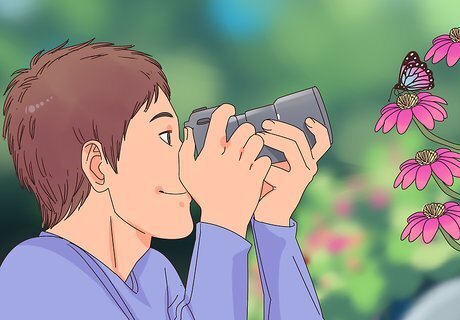
Take pictures every single day. This may seem obvious, but it is incredibly important. In order to reach this level of the industry, you need to eat, sleep and breathe photography. Take pictures every day and know every single thing there is to know about your camera. Photography is not a cheap hobby but owning different types of cameras can help you become an even better photographer. National Geographic doesn’t require a specific type of camera for their shoots, so the more cameras you are comfortable handing, the better. Nat Geo encourages photographers to shoot using experimental styles and techniques. However, the company does not want photos that are heavily-edited or manipulated. Make it a goal to become as good at capturing your vision with the initial photo as possible.
Maximizing Your Chances for a National Geographic Assignment
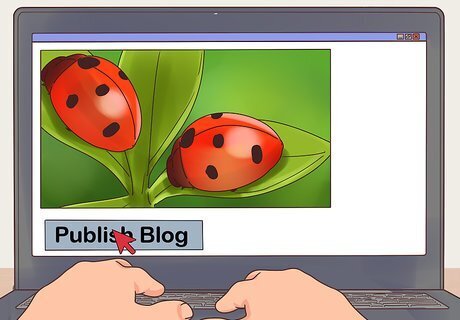
Try to get your work published in multiple places. The editors at National Geographic are constantly combing through books, magazines, newspapers, and online articles to find photographers who consistently capture their attention. Once they see someone’s name over and over again, they will look to get in contact with them. This process can take time. After all, Nat Geo is looking for veteran photographers, so keep at it! As a former director of photography at National Geographic used to say: “If we want to hire you, we already know who you are!” When Nat Geo editors reach out, they are usually looking to see if you have good story ideas. Take some time every day to think about stories you would like to tell. The more important the story is to you, the easier it will be for you to tell it to the world.
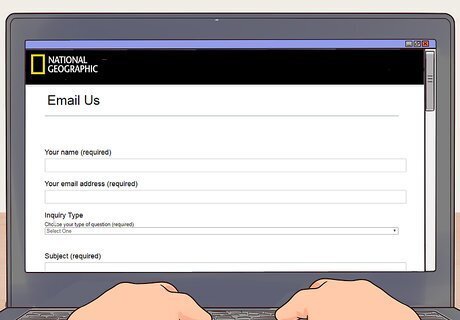
Contact an editor at National Geographic. Photography is no different than most fields in that it’s all about who you know and who knows you. While the email addresses of the top editors at the publication are not publicly available, check out National Geographic’s website to find which email would be best for sending work in. Email your work to as many different addresses as you can. This gives you a better chance of being noticed.

Visit the National Geographic Headquarters in Washington D.C. While the headquarters do not offer tours, they do have a museum that is open to the public on the first floor of their building. The museum features rotating exhibitions and a comprehensive history of National Geographic. The headquarters are located at 1145 17th St. NW in D.C. Use this time to see what makes the photos in the exhibition pop and learn as much of the history of the publication as you can.

Network with current and former National Geographic photographers. The freelancers who have worked with Nat Geo know the editors and other important people and can pass along your work to them. When you do get in contact with a Nat Geo photographer, make sure to keep in touch consistently and ask for advice. National Geographic photographers often host seminars around the country. Look up a photographer you admire to see when and where that person will be speaking next. Stay after the talk to introduce yourself, as nothing beats an in-person introduction! Networking isn’t just about finding the people who can hire you for your dream job. It’s about building relationships and getting feedback on your work. Don’t be afraid to ask accomplished photographers for their thoughts on your best stuff. This is a great way to maintain a relationship with someone in the field.
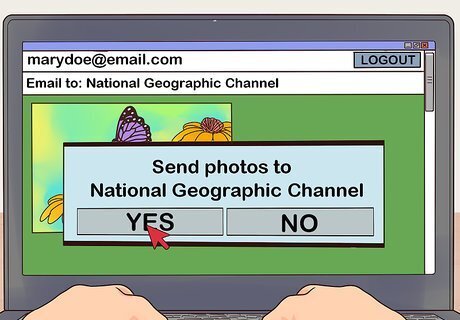
Send National Geographic clips of your best work every few months. There are thousands of aspiring photographers who want their work in National Geographic, which means the editors get photos every single day. In order to keep their attention, you must consistently send them your best work. Doing so just once most likely isn’t good enough. Joel Sartore sent his work to National Geographic’s Washington D.C. headquarters every three months. This eventually led to a one-day assignment with the magazine, which was soon followed by more work. There is a delicate balance to sending your work to Nat Geo. Being persistent is a good thing, but being a pain is not. If you are constantly contacting the people at National Geographic, you could come across as annoying and make it that much more difficult for you to latch on with the company.
Taking Advantage of Photography Opportunities

Apply for Nat Geo's photography internship if you’re in college. This is an incredibly selective program, as Nat Geo accepts only one intern per year. The University of Missouri runs a contest called the “College Photographer of the Year” and the winner is selected as Nat Geo’s intern. The 73rd edition of this contest featured nearly 10,000 images from students all over the world. Go over your work carefully to see which photo is your best!

Join “Your Shot” to become part of the Nat Geo community. Create an account on National Geographic’s website for a chance to work alongside some of the brightest minds in the industry. Send in your best photos for a themed assignment to have a chance at being part of a published story. Joining this community also allows you to get feedback on your work from some of the top names in the field as well as study their work. It is free to set up a “Your Shot” account. If your work continually gets noticed, you have the chance to go on assignment with National Geographic. You would get paid about 500 dollars per day for going on assignment.
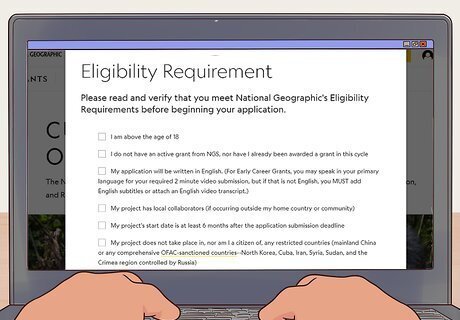
Propose a project to get a grant from Nat Geo. The company offers three types of grants: early career, exploration, and requests for proposals. Early career grants are meant to give less-experienced photographers a chance to lead a project. An exploration grant is a funding request made by an experienced project leader in the areas of education, conservation, storytelling, research, and technology. A request for proposal is when an applicant pitches a project that focuses on a certain key issue. These include documenting human migration and species recovery. You must be at least 18 years old to apply for an early career grant. Grant projects last one calendar year or less. Early career grants are typically funded for 5,000 dollars and cannot exceed 10,000 dollars. Exploration grants feature between 10,000 and 30,000 dollars in funding. You can apply for a Nat Geo grant even if you have already applied for one in the past. All you have to do is close your previous grant record. The grant program is highly competitive and Nat Geo receives far more applications than it can fund.



















Comments
0 comment